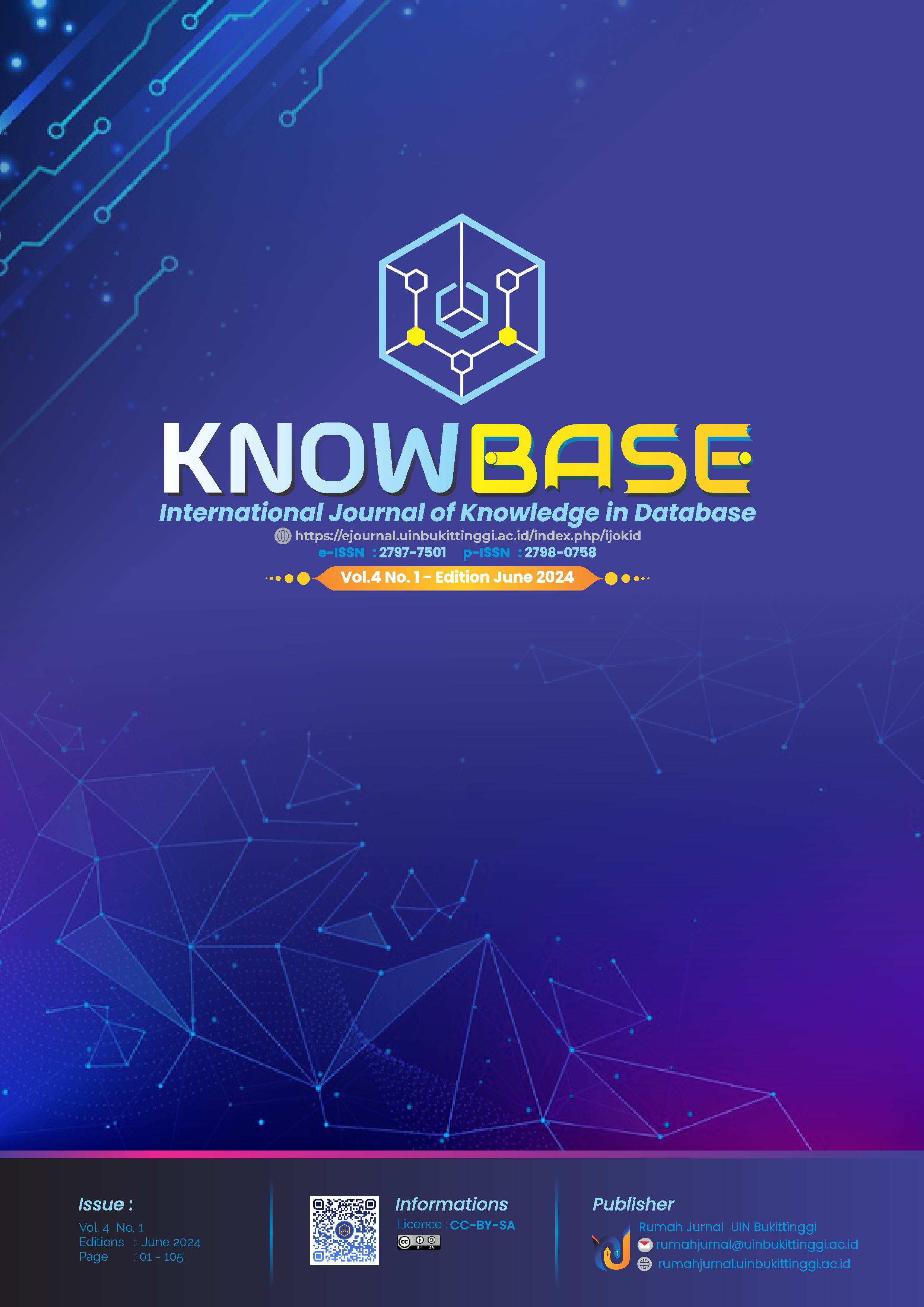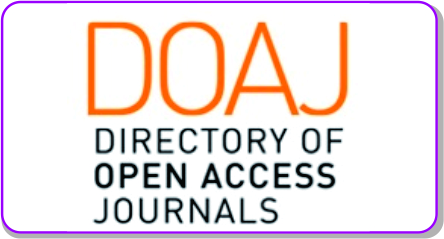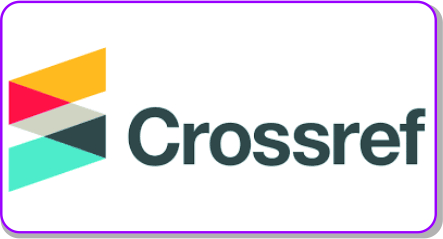Implementation of Convolutional Neural Networks (CNN) in An Emotion Detection System for Measuring Learning Concentration Levels
DOI:
https://doi.org/10.30983/knowbase.v4i1.8429Keywords:
CNN, Concentration on Studying, Learning ConcentrationAbstract
Technological advancements have had a significant impact on the education sector, including the application of Convolutional Neural Networks (CNN) for facial image analysis. This research aims to implement CNN to measure students' learning concentration levels. The FER2013 dataset, which includes seven emotion classifications and comprises 28,709 images for training data, is used as the database. The data is processed through rescaling and augmentation to prepare the CNN model. The model consists of several convolutional layers, pooling layers, and fully connected layers designed to extract crucial features from facial images. Evaluation results demonstrate a very high accuracy of 94.95% on training data, indicating that the model effectively recognizes complex patterns within the data. Although there is a higher loss value of 157% and a decreased accuracy of 62.75% on validation data, this suggests that the model possesses a strong foundational capability and can still be improved through further adjustments. With high accuracy in training and promising validation results, the model shows substantial potential for real-world application, where it can assist teachers in understanding students' emotional responses in real-time. The implementation of CNN aids educators in comprehending students' emotional responses and adapting their teaching methods more effectively, thereby creating a more conducive learning environment and enhancing students' academic and social development. These findings also open opportunities for further research to improve the performance and generalization of the model on unseen data, making this technology an increasingly reliable tool in education
References
N. Agustian and U. H. Salsabila, “Peran Teknologi Pendidikan dalam Pembelajaran,” Islamika, vol. 3, no. 1, pp. 123–133, 2021, doi: 10.36088/islamika.v3i1.1047.
O. Ekundayo and S. Viriri, “Multilabel convolution neural network for facial expression recognition and ordinal intensity estimation,” PeerJ Comput. Sci., vol. 7, no. Cv, 2021, doi: 10.7717/peerj-cs.736.
P. A. Nugroho, I. Fenriana, and R. Arijanto, “Implementasi Deep Learning Menggunakan Convolutional Neural Network ( Cnn ) Pada Ekspresi Manusia,” Algor, vol. 2, no. 1, pp. 12–21, 2020.
H. Binghua, C. Zengzhao, L. Gaoyang, J. Lang, Z. Zhao, and D. Chunlin, “An expression recognition algorithm based on convolution neural network and RGB-D Images,” MATEC Web Conf., vol. 173, 2018, doi: 10.1051/matecconf/201817303066.
S. S. Ripan Septian, Dede Irawan Saputra, “Klasifikasi Emosi Menggunakan Convolutional Neural Networks Emotion,” in SENTER 2019: Seminar Nasional Teknik Elektro 2019, 2019, pp. 53–62. doi: 10.13733/j.jcam.issn.2095-5553.2022.11.026.
C. Rinjani, F. I. Wahdini, E. Mulia, S. Zakir, and S. Amelia, “Kajian Konseptual Model Pembelajaran Word Square untuk Meningkatkan Hasil Belajar Siswa,” J. Inovasi, Eval. dan Pengemb. Pembelajaran, vol. 1, no. 2, pp. 52–59, 2021, doi: 10.54371/jiepp.v1i2.102.
A. Werdayanti and L. Belakang, “Pengaruh Kompetensi Guru Dalam Proses Belajar Mengajar Di Kelas Dan Fasilitas Guru Terhadap Motivasi Belajar Siswa,” Din. Pendidik., vol. 3, no. 1, pp. 79–92, 2008, doi: 10.15294/dp.v3i1.434.
F. R. Chan, R. Yanti, and F. Annas, “Development of Interactive Artificial Intelligence-Based Learning Media Using Natural Language Processing Methods In the Subject of Informatics,” BiCED Proceeding, 2023, [Online]. Available: https://proceedings.uinbukittinggi.ac.id/biced/article/view/325
Abdullah Ali, “Peran Guru Dalam Pengelolaan Kelas,” J. Eksp. Media Ilm. Pendidik. Guru Madrasah Ibtidaiyah, vol. 10, no. 2, pp. 20–27, 2022, doi: 10.58645/eksperimental.v10i2.219.
T. Tinaliah, “Penerapan Convolutional Neural Network Untuk Klasifikasi Citra Ekspresi Wajah Manusia Pada MMA Facial Expression Dataset,” JATISI (Jurnal Tek. Inform. dan Sist. Informasi), vol. 8, no. 4, pp. 2051–2059, 2021, doi: 10.35957/jatisi.v8i4.1437.
E. Zohreh, M. Hosein, and M. Abdolah, “The role of teacher’s authority in students’ learning,” J. Educ. Pract., vol. 6, no. 19, pp. 1–16, 2015, [Online]. Available: https://files.eric.ed.gov/fulltext/EJ1079519.pdf
D. Alamsyah and D. Pratama, “Implementasi Convolutional Neural Networks (CNN) untuk Klasifikasi Ekspresi Citra Wajah pada FER-2013 Dataset,” J. Teknol. Inf., vol. 4, no. 2, pp. 350–355, 2020, doi: 10.36294/jurti.v4i2.1714.
J. F. Yeh, K. M. Lin, C. C. Chang, and T. H. Wang, “Expression Recognition of Multiple Faces Using a Convolution Neural Network Combining the Haar Cascade Classifier,” Appl. Sci., vol. 13, no. 23, 2023, doi: 10.3390/app132312737.
A. Rosebrock, Deep Learning for Computer Vision with Python. Pyimagesearch. 2018.
Y. Wang, Y. Li, Y. Song, and X. Rong, “The influence of the activation function in a convolution neural network model of facial expression recognition,” Appl. Sci., vol. 10, no. 5, 2020, doi: 10.3390/app10051897.
Z. Wang and L. Yao, “Expression Recognition Method Based on Convolutional Neural Network and Capsule Neural Network,” Comput. Mater. Contin., vol. 79, no. 1, pp. 1659–1677, 2024, doi: 10.32604/cmc.2024.048304.
A. M. Sarıgül M, Ozyildirim BM, “Differential convolutional neural network,” Neural Netw, no. 116, pp. 279–287, 2019.
F. R. Chan, D. Harni, M. Ramadhani, Hanifah, and L. Efriyanti, “Perancangan Aplikasi Pengelolaan Gudang Berbasis Android Menggunakan Android Studio,” vol. 3, no. 2, p. 103, 2022, doi: 10.24843/ejmunud.2019.v08.i12.p16.
F. R. Chan and E. Maiyana, “Perancangan Aplikasi Pengelolaan Toko Berbasis Web,” J. Teknol. Dan Sist. Inf., vol. 4, no. 1, pp. 75–80, 2023, [Online]. Available: http://jim.teknokrat.ac.id/index.php/sisteminformasi/index
K. Khoirullah, S. Supriadi, S. Zakir, and L. Efriyanti, “Designing a Student Violation Point System Based on Telegram Using PHP Programming Language,” Knowbase Int. J. Knowl. Database, vol. 3, no. 2, p. 131, 2023, doi: 10.30983/knowbase.v3i2.7192.
M. F. Prayuda, “Classification of Sad Emotions and Depression Through Images Using Convolutional Neural Network (CNN),” J. Inform. Univ. Pamulang, vol. 6, no. 1, p. 90, 2021, doi: 10.32493/informatika.v6i1.8433.
P. Musa, W. K. Anam, S. B. Musa, W. Aryunani, R. Senjaya, and P. Sularsih, “Pembelajaran Mendalam Pengklasifikasi Ekspresi Wajah Manusia dengan Model Arsitektur Xception pada Metode Convolutional Neural Network,” Rekayasa, vol. 16, no. 1, pp. 65–73, 2023, doi: 10.21107/rekayasa.v16i1.16974.
M. Shovian, H. Al, A. P. Kharisma, and N. Santoso, “Pengembangan Aplikasi Sistem Informasi Manajemen Gudang Berbasis Web Menggunakan Metodologi Agile ( Studi Kasus : CV . Jaya Laksa Lestari ),” J. Pengemb. Teknol. Inf. dan Ilmu Komput., vol. 1, no. 1, pp. 1–10, 2020.
Downloads
Published
Issue
Section
Citation Check
License
Copyright (c) 2024 Fajri Rinaldi Chan, Firdaus Annas, Yulifda Elin Yuspita, Gusnita Darmawati

This work is licensed under a Creative Commons Attribution-ShareAlike 4.0 International License.
Authors who publish with this journal agree to the following terms:
- Authors retain copyright and grant the journal right of first publication with the work simultaneously licensed under a Creative Commons Attribution License that allows others to share the work with an acknowledgment of the work's authorship and initial publication in this journal.
- Authors are able to enter into separate, additional contractual arrangements for the non-exclusive distribution of the journal's published version of the work (e.g., post it to an institutional repository or publish it in a book), with an acknowledgment of its initial publication in this journal.
- Authors are permitted and encouraged to post their work online (e.g., in institutional repositories or on their website) prior to and during the submission process, as it can lead to productive exchanges, as well as earlier and greater citation of published work (See The Effect of Open Access).














